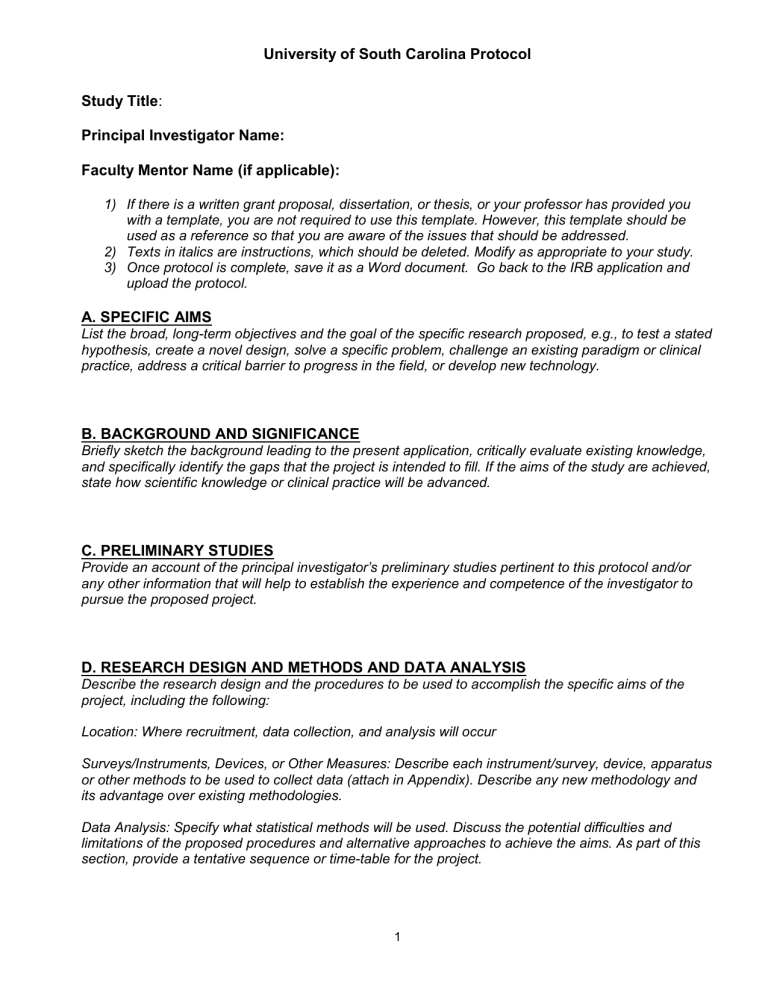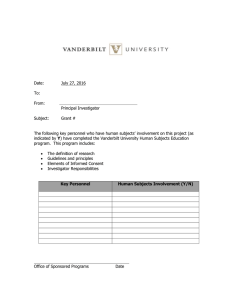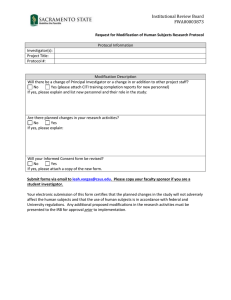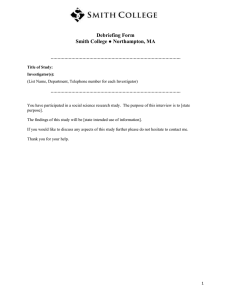
University of South Carolina Protocol Study Title: Principal Investigator Name: Faculty Mentor Name (if applicable): 1) If there is a written grant proposal, dissertation, or thesis, or your professor has provided you with a template, you are not required to use this template. However, this template should be used as a reference so that you are aware of the issues that should be addressed. 2) Texts in italics are instructions, which should be deleted. Modify as appropriate to your study. 3) Once protocol is complete, save it as a Word document. Go back to the IRB application and upload the protocol. A. SPECIFIC AIMS List the broad, long-term objectives and the goal of the specific research proposed, e.g., to test a stated hypothesis, create a novel design, solve a specific problem, challenge an existing paradigm or clinical practice, address a critical barrier to progress in the field, or develop new technology. B. BACKGROUND AND SIGNIFICANCE Briefly sketch the background leading to the present application, critically evaluate existing knowledge, and specifically identify the gaps that the project is intended to fill. If the aims of the study are achieved, state how scientific knowledge or clinical practice will be advanced. C. PRELIMINARY STUDIES Provide an account of the principal investigator’s preliminary studies pertinent to this protocol and/or any other information that will help to establish the experience and competence of the investigator to pursue the proposed project. D. RESEARCH DESIGN AND METHODS AND DATA ANALYSIS Describe the research design and the procedures to be used to accomplish the specific aims of the project, including the following: Location: Where recruitment, data collection, and analysis will occur Surveys/Instruments, Devices, or Other Measures: Describe each instrument/survey, device, apparatus or other methods to be used to collect data (attach in Appendix). Describe any new methodology and its advantage over existing methodologies. Data Analysis: Specify what statistical methods will be used. Discuss the potential difficulties and limitations of the proposed procedures and alternative approaches to achieve the aims. As part of this section, provide a tentative sequence or time-table for the project. 1 University of South Carolina Protocol E. PROTECTION OF HUMAN SUBJECTS 1. TARGET POPULATION: Discuss the population you are targeting for the study (e.g., college students, elementary school students, adults with aphasia), the demographics of the population, any inclusion or exclusion criteria, and your anticipated sample size including method used to determine sample necessary to accomplish aims. 2. RECRUITMENT PLANS: Describe how potential subjects will be recruited to participate; if an advertisement, recruiting letter or other materials will be used, the IRB must review and approve (attach in Appendix). If you will be recruiting on another institution’s property, describe plans to obtain approval from that institution to recruit on their property 3. EXISTING DATA/SAMPLES: If the investigator plans to utilize data or samples that are in existence (the investigator will not be recruiting/consenting subjects), describe where the data/samples are housed, how the investigator will gain access to the data/samples, whether the data/samples contain any direct identifiers (e.g., names, address, telephone numbers) or are coded and who will have access to the key to the code (i.e., will the USC investigator have access to key), whether the investigator will sign any data use agreement, and how data will be recorded by USC investigator. 4. CONSENT/ASSENT: Describe procedures to be used to obtain consent/assent of subjects, including means that will be used to minimize any risks of coercion or undue influence. 5. POTENTIAL RISKS: Describe any possible risks that participants may incur by participating in the study,the likelihood of the risk occurring, and any procedures that will be taken to minimize those risks. Describe procedures to treat or refer the subject for treatment (including who will be responsible for payment for any costs incurred), and for notifying the IRB should an adverse event occur. 6. POTENTIAL BENEFITS: Describe the potential benefits of the research to the subjects and/or others.Explain why the risks to subjects are reasonable in relation to the anticipated benefits to subjects and others. 7. CONFIDENTIALITY Describe procedures for protecting the identity of the participant; how data will be collected, stored, and used. Be certain to state whether data will be anonymous (meaning not even investigator will be able to link data with identities of participants) or confidential (meaning the investigator will maintain a key/link.) 2 University of South Carolina Protocol 8. COMPENSATION: Explain whether and/or how participants will be compensated for participation in the study (e.g., course credit, cash, gift card). Compensation should not unduly influence subjects to participate. 9. WITHDRAWAL: Include a statement describing procedures to allow subjects to voluntarily withdraw from the study without negative consequences. If monetary compensation, discuss whether or not participants will still receive compensation if they terminate before completion. If extra course credit is to be awarded, discuss whether or not participants will receive extra credit if they withdraw before completion, and alternate commensurate means available to subjects to obtain credit. F. REFERENCES/LITERATURE CITATIONS List all references. Each reference must include the title, names of all authors, book or journal, volume number, page numbers, and year of publication. The reference should be limited to relevant and current literature. It is important to be concise and to select only those literature references pertinent to the proposed research. G. APPENDIX Attach any additional information pertinent to the application, such as surveys or questionnaires, etc. 3


